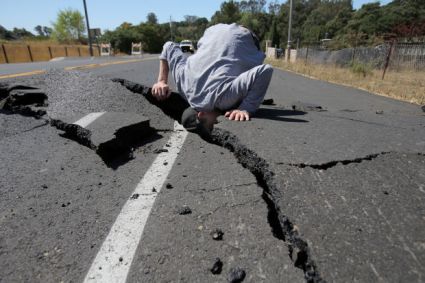We’ve witnessed two major earthquakes in the past month, but other than the fact that our college has an inefficient evacuation system in place, what have we really learnt? Nothing. Let’s fix that.
- The Richter Scale is a non-linear, logarithmic scale
Say whaaa? If you threw out any and all understanding of Math along with your R.D. Sharma after your tenth boards, allow me to explain. A linear scale is one where each point on the scale is as far away from the previous point as it is from the next; that is to say the points are set apart by equal intervals. The ruler you use to draw lines everyday could be an example of a linear scale. A logarithmic scale is one where the intervals increase exponentially, i.e. the distances between each point on the scale are not uniform and instead, are constantly increasing.
So, when I casually found out that the Richter scale was a base-10 logarithmic scale, you can imagine why I felt the need to sit down and read up on the mysterious occurrences that are earthquakes.
Wait, base-10? What does that even mean? That an earthquake of magnitude 5.0 on the Richter scale is ten times bigger than one with a magnitude of 4.0, one hundred times as big as a 3.0 magnitude earthquake, and so on. Puts every decimal point in perspective, doesn’t it?
But wait! That’s not all. The Richter scale compares the amplitudes of seismic waves, and in that sense tells you the size of earthquakes. However, it doesn’t represent the real strength of earthquakes and the destruction and damage they can cause. In terms of energy release, a 6.0 magnitude earthquake would be around 1000 times stronger than a 4.0 earthquake. Suddenly, those numbers you read in news reports seem a lot scarier.
- There are several million earthquakes every year
Not hundreds, not thousands, but millions. And there probably is one occurring right now, as I type this out. My Earthquake Tracker app tells me that the last earthquake occurred five minutes ago in California.
But, most residents of the Golden State probably aren’t privy to the information that they just experienced an earthquake – most earthquakes with a magnitude of less than 2 aren’t even felt and pass by like a summer breeze, for the most part (or, if you are as oblivious as yours truly, even magnitude 5 earthquakes pass by unnoticed). And, a vast majority of the earthquakes that take place every year fall in this category of low-intensity quakes, also called microearthquakes.
- The Richter scale was last used in the 1970s
The newspapers have been lying to you. For the past few decades, seismologists have not been following the method originally used by Charles Richter because of its inaccuracy. For higher magnitude (>7) earthquakes, the moment magnitude scale gives more accurate results. However, the different methods used have been calibrated to be consistent with the Richter scale – hence the confusion and continued misattribution to the Richter scale.
The moment magnitude scale measures what is known as the ‘moment’ of an earthquake (essentially, the energy released by an earthquake) – a product of the slip or distance a fault has moved, and the force required to move it. While the Richter scale uses only information from seismographs, the moment magnitude scale uses this, but also looks at the physical effects of the earthquake and hence is more comprehensive.
- Foreshocks are a thing
Everyone’s heard of aftershocks – smaller earthquakes that occur after the main earthquake is over. But, sometimes, an earthquake might not be a mainshock – but might just be a foreshock, a smaller preceding earthquake, to something much bigger. Foreshocks are sometimes useful in predicting when an earthquake is going to hit, but are limited in their utility since they don’t always precede an earthquake.
So, if you’ve just experienced an earthquake and think it’s all over, stop and think again. You might have to brace yourself for something much worse coming your way.
Bonus fact: In a law school far, far away from any signs of civilisation, there lives a class of students and faculty so brave, and so highly dedicated to their academic endeavours that not even an earthquake can shake their resolve to stay inside class (except, of course, a notice by the Registrar).


2 responses to “Things You Probably Didn’t Know About Earthquakes”
i knew all of this
LikeLike
nooooooo
LikeLike